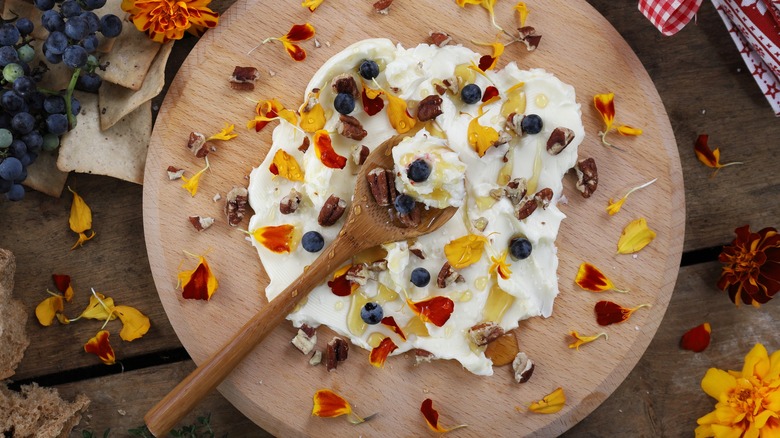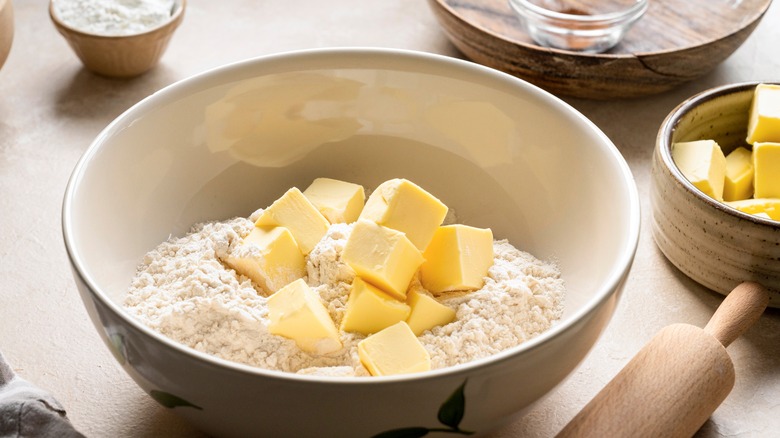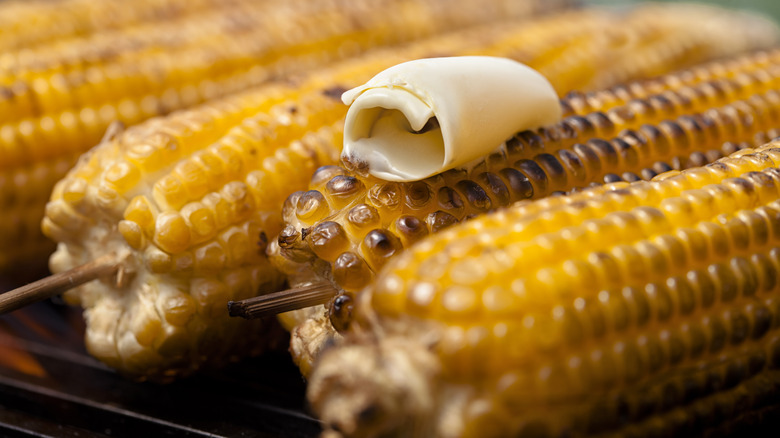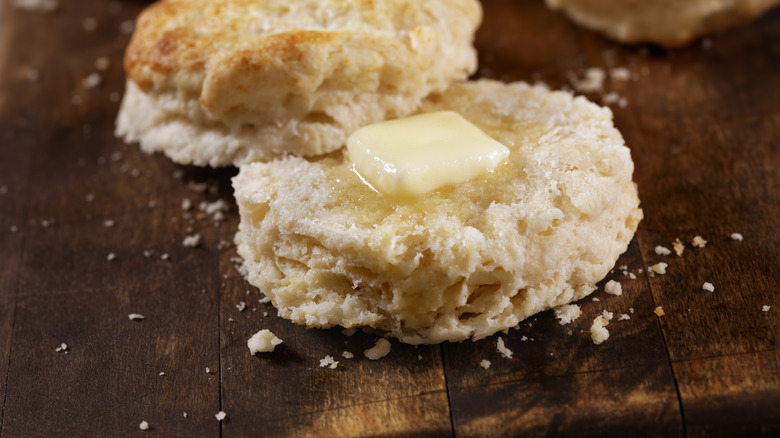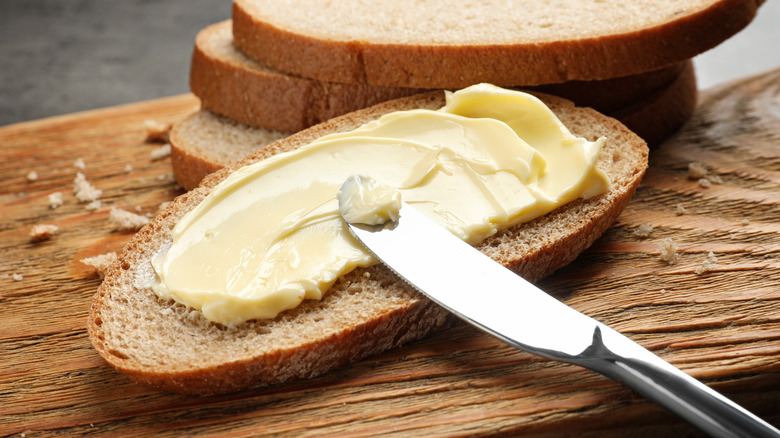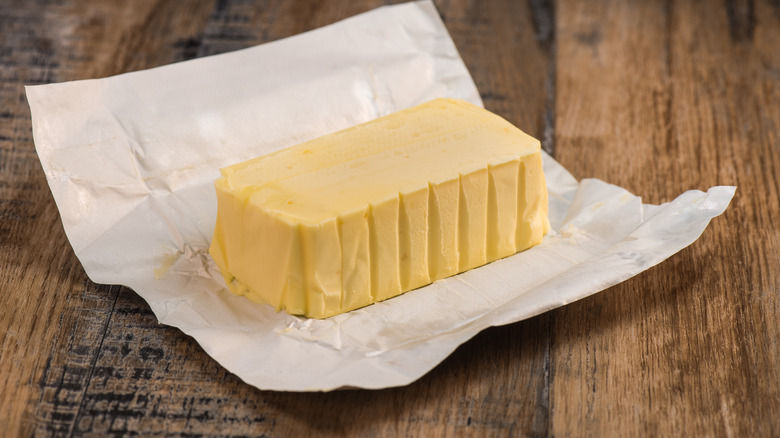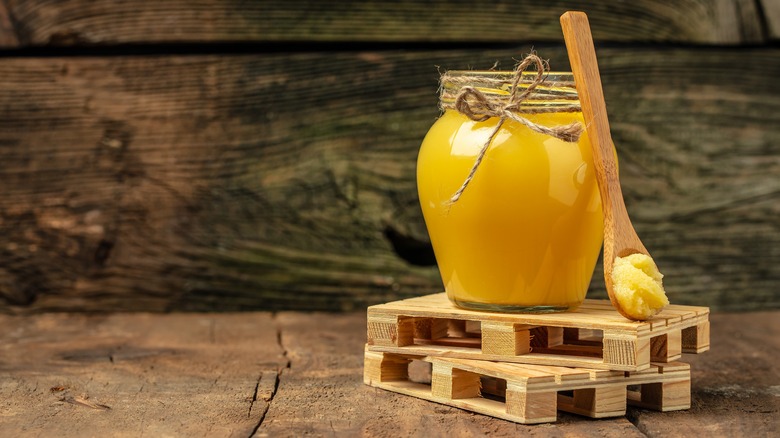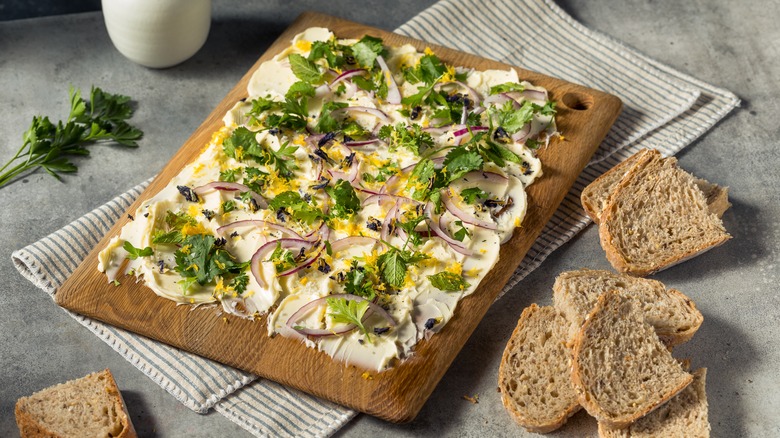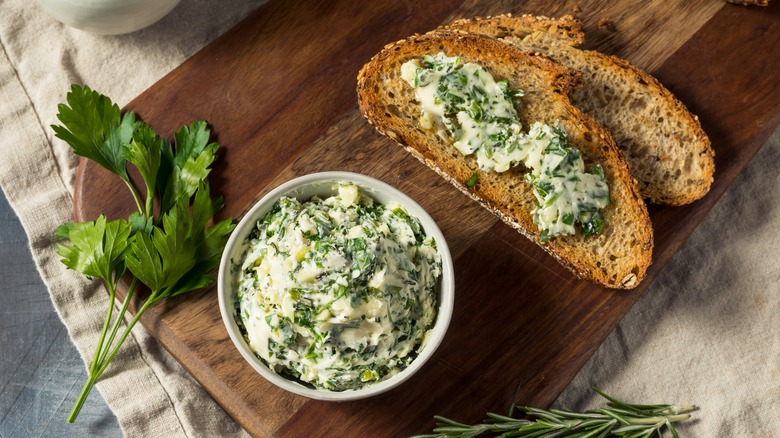What Are The Different Kinds Of Butter (And How Do I Use Them)?
Butter is one of those magical ingredients that can instantly transform an ordinary dish into something luxurious. Croissants are flaky thanks to sheets of cold butter, movie-time popcorn wouldn't be the same without a drizzle of melted butter, and many foods owe their glossy sheen, tender texture, and smooth consistency to this dairy-based fat. In fact, butter alone can make for an exquisitely rich meat or pasta sauce — though the help of garlic and herbs is always welcome.
There is no doubt that butter has the Midas touch when it comes to food but to truly unlock its full potential, it's important to use the right type of butter in the right setting. You wouldn't want to use too much salted butter in a sweet recipe or the wrong type of butter for high-heat cooking now, would you? There are dozens of different types of butter, each with different flavors, textures, and fat content that can affect cooking. While any butter is rarely an unwelcome addition to food, there are certainly more appropriate ways to use butter depending on its type.
Unsalted butter
Butter is made by churning pasteurized cream until the fatty part — known as butterfat or milkfat — separates from the rest of the liquid. From here, the glob of fat is either rinsed and mixed with salt to make salted butter, or it is rinsed and left as it is to make the unsalted kind. While the only difference between the two types of butter is the presence of salt, the inconspicuous little seasoning can change the way each butter is used.
Unsalted butter is excellent for baking where salt needs to be used in precise measurements — or in any recipe where the amount of salt needs to be controlled. This is also why unsalted butter is often preferred by chefs who'd rather season their cooked meals with salt themselves than let salted butter do it for them. Plus, because unsalted butter is essentially just cream and little else, it's considered the purest form of butter with a sweet, neutral flavor unlike any other.
That being said, the neutral and bland flavor of unsalted butter may leave much to be desired if all you want is a salty slice of buttered toast. Moreover, salt also doubles up as a preservative, so without any salt to prolong its shelf life, unsalted butter is more susceptible to spoilage.
Salted butter
Due to its easy availability and popularity, salted butter is pretty much synonymous with butter as a whole. Salted butter is essentially just standard cream butter with the addition of salt in it, but the real catch here is the exact amount of salt that it's going to have. In general, the amount of salt in salted butter ranges anywhere from 1.25 to 1.75 percent of the total weight of the butter, but the exact ratio varies depending on the brand. So, if you've just switched to a new brand of butter and are wondering why your food has started tasting a tad more salty, chances are that the butter you used had a higher proportion of salt.
Salted butter has both its advantages and disadvantages. The added salt is the reason why the otherwise bland cream butter has that rich, sweet, and buttery flavor. Salted butter is excellent for dunking warm bread into, slathering on warm pancakes and toast, brushing onto corn cobs, and for most savory applications where the salt is a welcome addition. The only thing to be careful of is to adjust any salt that you would add on top.
Any recipe that requires you to be tight-fisted with salt — baking for example — is where salted butter may be a misfit because you won't have control over how much saltiness the butter adds to your dish. Additionally, salted butter also has higher water content than its unsalted counterparts, which can lead to disastrous results in baking.
Cultured butter
Where salted and unsalted types of butter are just forms of churned cream, cultured butter undergoes one additional step: It is made by adding live culture to pasteurized cream, allowing the cream to slowly ferment over time, and then churning the fermented cream into butter. The result is an acidic butter with a creamy texture that has some tang and sharpness to it, and which somehow tastes more rich and, well, buttery than other types of butter.
The uniquely rich and tangy flavor of cultured butter, plus the creamy texture that makes it more spreadable, shines most when it works alone, slathered onto toast, scones, and pancakes for example, or in bakes like biscuits and shortbread cookies where the flavor of the fat is more pronounced. Cultured butter also has a high content of butterfat, which makes for flaky pies and croissants. The only downside of cultured butter is that it can be more expensive than everyday slabs of salted and unsalted butter, so if you're working on a recipe that calls for heaps of fat, it may be wiser to hold off on the cultured variety.
European butter
Just as American butter is popular in the U.S., other types of butter are popular in other parts of the world. Moroccans prefer smen, a type of clarified butter known as ghee is popular in South Asia, and European butter comes from, you guessed it, Europe. European-style butter, however, has become increasingly sought-after in the U.S. as well, mainly for one reason — its superior butterfat content can sometimes be a great advantage.
American butter — whether salted or unsalted — must have at least 80 percent butterfat for it to meet the standards of butter set by the USDA, but European butter must have at least 82 to 90 percent of it. This makes European butter softer, more golden yellow in color, richer and more complex in flavor, and easier to melt. A higher butterfat content also means that there is less space for water in the butter, which makes European butter excellent for baking. Sadly, its high-fat content makes European butter a tad more expensive to make, which means it often comes with a higher price tag too.
Irish butter
Technically, Irish butter is European butter — but that doesn't mean that all European butter is Irish. Rather, Irish butter is a type of European butter that follows the 82 percent butterfat content requirement set forth by the EU. Types of European butter, however, greatly differ based on their methods of process, the breed of cows from which the cream comes, the diet of said cows, and the climatic conditions of the region. When it comes to Irish butter, Ireland's wide green pastures and grass-fed cows are what make the country's butter so different.
Americans can buy the Irish stuff thanks to brands like Kerrygold. It has a sweeter flavor than American butter and a bright golden-yellow tint that is unlike any other type of butter. This distinct color comes from the reddish-orange pigment found in beta carotene — which also gives fruits and veggies like carrots their color — which is in bountiful supply in the pastures of Ireland.
The rich and creamy Irish butter can be used in all kinds of sweet and savory cooking, but the color of Irish butter is best appreciated in simple settings, think toast, corn, vegetables, and butter boards. Its high-fat content also gives Irish butter all the benefits of European butter in baking. Irish butter even makes for an excellent brown butter with hazelnut and caramel-like flavor.
Clarified butter
Butter is many things, but one thing that it can't do very well is high-heat cooking. This is because butter is made of three things: fat, water, and milk solids. Most types of butter are made of at least 80 percent of fat, which means the rest of it is made of water and easy-to-burn milk solids. Clarified butter is essentially made by boiling butter until all three components separate; the water evaporates, and the milk solids foam up and then settle on the bottom, leaving a layer of aromatic fat on top called clarified butter or liquid gold.
While butter starts burning at 350 degrees F, clarified butter has a smoke point of 450 degrees F, which is higher if not on par with the likes of canola oil. This makes clarified butter excellent for high-heat cooking like frying, searing, and roasting. Its nutty and toasted flavors make clarified butter an excellent finishing fat on all kinds of savory foods, from eggs and rice to popcorn, potatoes, and everything in between. Clarified butter's stability is also why it's an excellent fat to use in temperamental sauces like hollandaise.
Ghee, a type of clarified butter popular in Indian cuisine, is made by cooking butter for even longer until all the milk solids turn brown, leaving an even more intense and nutty flavor behind. Plus, ghee has long been used for its vitamins, antioxidants, and digestion-aiding properties in the Ayurvedic medicinal system, so it may just be the one butter that isn't all that bad for your health.
Goat butter
Though the intensity of their color may vary, most types of butter come in a shade of yellow. That, however, is not the case with goat butter, which has the same pale white hue as goat milk and goat cheese. This is because goats don't digest beta-carotene the way that cows do, and so the milk lacks the colored pigment of cow milk butter.
Goat butter packs bold notes of earthy and tangy flavors, which are far from the flavors of most butter made from cow milk — though that punchiness may not be everyone's cup of tea. Those who do appreciate the flavor of goat butter will find it an excellent addition to butter boards and in anything that could do with its soft and pliable consistency. For others, goat butter may work better in sweet and savory recipes where stronger ingredients can balance its flavor. Moreover, its fluffy texture also means that goat butter tends to melt much more quickly, which can be a great thing for moist quick bread and recipes that use laminated dough.
Compound butter
Compound butter may seem like the name for a very complex stick of butter, but it's not: It's simply regular butter that's been softened and then mixed with other sweet or savory ingredients like fresh or dried herbs, alliums, and spices, or even honey, nuts, and berries.
The addition of other components adds even more flavor to butter, making compound butter an excellent secret weapon in your culinary arsenal. Sweet compound butter can add an oomph to plain slices of toast, bread, muffins, and scones — whereas savory compound butter like garlic, basil, or tomato butter can elevate seared meats, rich pasta sauces, and bland rice or vegetables.
Unlike other types of butter, it's incredibly easy to make compound butter at home. All you have to do is pick some butter, allow it to soften, and then whip it into a fluffy cloud. Fold in your mix-ins, transfer the compound butter onto parchment paper, and simply shape it before popping it back in the refrigerator. Although it doesn't matter whether you use salted or unsalted butter, it's always easier to start with unsalted butter and then add salt to it, especially if you're making a sweet compound butter.

